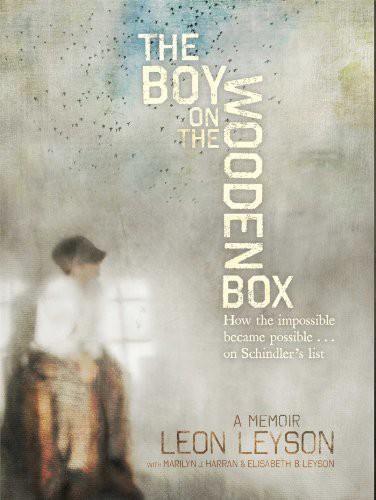
The Boy on the Wooden Box
How the Impossible Became Possible . . . on Schindler's List
فرمت کتاب
ebook
تاریخ انتشار
2013
Lexile Score
1000
Reading Level
5-7
ATOS
7
Interest Level
4-8(MG)
نویسنده
Elisabeth B. Leysonشابک
9781442497832
کتاب های مرتبط
- اطلاعات
- نقد و بررسی
- دیدگاه کاربران
نقد و بررسی

lulubob - "The Boy on the Wooden Box" is a wonderful book that I highly recommend. I seriously read it in one day and I still had time to start a new book. It was THAT GOOD! "The Boy on the Wooden Box" is a true story of Leon Leyson who was one of the youngest people to be put on Schindler's list. Leon tells his horrible beyond belief war stories. When a Polish & Jewish boy named Leon was about 8 there were signs of a war to come. When he was about 10 the war began. It started as "Jews can't do this and Jews can't do that" but nothing too extreme. Then the Germans then started banning Jews from schools. The Nazis try to make their lives harder by forbidding them from sitting on park benches well parks in general. These Germans make them wear stars on their sleeves to identify who they are. But since Leon is younger than 12 he doesn't need to wear a star. His friends stopped acknowledging him because he is a Jew. Oskar Schindler the Nazi gives Leon's father a job and things finally look hopeful. But when the Leyson family were evicted and sent to a Jewish Ghetto in Kraków, Poland everything dramatically changes. But things turn up for a while when Schindler gives work to Leon, his brother David, and his mother. Leon's family struggles to find work and are faced with starvation. As a growing boy he rummages through garbage cans to find at least a potato peel. He changes Ghettos and goes to a concentration camp but ultimately has kind Schindler to watch out for him and anyone else that works for him. This is an amazing book I did not want to put down. "The Boy on the Wooden Box" really shows the horrors of WWII and makes you feel so grateful for all you have been given and how lucky you are to have a roof over your head, warm food to eat, and clothes to wear. A fantastic read!

Starred review from July 1, 2013
Leyson, who died in January at age 83, was No. 289 on Schindler’s list and its youngest member. He was just 13 when Leyson’s father convinced Oskar Schindler to let “Little Leyson” (as Schindler knew him) and other family members find refuge in the Emalia factory; Leyson was so small he had to stand on a box to work the machinery. Leyson and his coauthors give this wrenching memoir some literary styling, but the book is at its most powerful when Leyson relays the events in a straightforward manner, as if in a deposition, from the shock of seeing his once-proud father shamed by anti-Semitism to the deprivation that defined his youth. Schindler remains a kindly but enigmatic figure in Leyson’s retelling, occasionally doting but usually distant. Leyson makes it clear that being “Schindler Jews” offered a thread of hope, but it never shielded them from the chaos and evil that surrounded them. Readers will close the book feeling that they have made a genuinely personal connection to this remarkable man. Ages 9–14. Agent: Peter Steinberg, the Steinberg Agency. (Aug.) ■

November 1, 2013
Gr 5-8-Leyson describes his childhood prior to the Nazi invasion of Poland as "a world defined by the love and warmth of family." In 1938, he moved with his mother and four older siblings from a small village to join his father, who was working in the city. But soon after, everything changed as the Nazis "tightened their grip on Krakow." Through luck, skill, and tenacity, Leyson's father became one of Oskar Schindler's first Jewish workers and managed to secure a place on his notorious list for his wife and children. Throughout his six years of immense suffering, including in the Plaszow work camp, Leon was convinced that his luck would eventually run out. But Schindler made sure that didn't happen. In 1949, at age 19, Leon immigrated to America with his parents. He served in the U.S. army during the Korean War, went to school on the GI Bill, and taught high school in southern California for 39 years. But he rarely spoke about his wartime experience until Steven Spielberg's film was released. As Leyson explained: "Maybe I hadn't really been ready to speak about my experiences...or maybe people hadn't really been ready to listen, or maybe both." But for the next 18 years, he spoke to countless church, synagogue, and school groups and was encouraged to write his story. He died in January 2013 without knowing that his book would be published. Black-and-white photographs of the Leyson family before and after the war are appended. This powerful account succeeds at putting a face and a name, and a fully developed story, to one of the nearly 1200 Jews who were saved by Oskar Schindler. Leyson's clear, concise, and accessible narrative is profound and inspiring.-Rachel Kamin, North Suburban Synagogue Beth El, Highland Park, IL
Copyright 2013 School Library Journal, LLC Used with permission.

























دیدگاه کاربران